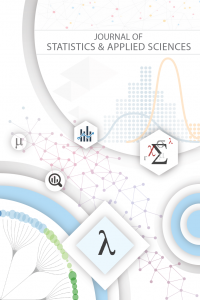Avrupa Zaman Kullanımı Verisi için Görsel ve Bütünleşik Veri Analizi
Zaman kullanım verileri, sosyologlar, psikologlar, istatistikçiler vb. gibi birçok araştırmacının ilgisini çeken bir veridir. Bu tür veriler doğası gereği çok değişkenlidir ve çok değişkenli verilerin bir alt türü olarak, bütünleşik veriler olarak adlandırılır. Böylece zaman kullanım verileri, bütünleşik veri analiz teknikleri ile de analiz edilebilir ve görselleştirilebilir. Literatürde bu durumdan nadiren bahsedilmektedir; genellikle analizler ve zaman kullanımı verilerinin görselleştirilmesi çok değişkenli gerçek uzayda gösterilir. Ancak b, verilerin yanlış yorumlanmasına yol açabilir ve hatta bazı çok değişkenli istatistiksel analizler bir dönüşüm yapılmadan önce doğrudan uygulanamayabilir. Bu çalışmanın ana katkısı, zaman kullanım verileri için bir analizin nasıl kullanılabileceğini ve veri setinin bu yeni düzenlemesinden kompozisyon parçaları olarak ne gibi faydalar elde edilebileceğini göstermektir. Gerçekten de zaman kullanım verisi için elde edilen sonuçlar , geleneksel teknikler ile bütünleşik veri analizi arasında bazı farklılıklar olduğunu göstermektedir.
Anahtar Kelimeler:
Zaman Kullanım Verisi, Bütünleşik Veri, Log-oran Analizi, Kümeleme Analizi, Üçgen diyagramı
Visualizations and Compositional Data Analysis for the European Time Use
Time use data is a specific data that is of interest to many researchers such as sociologists, psychologists, statisticians and etc. It is multivariate by nature and can be seen as a subtype of multivariate data called compositional data. Thus, time use data can also be analyzed and visualized by compositional data analysis techniques. This is rarely mentioned in literature; usually analyses and visualizations of time use data is shown in multivariate real space. However, this may lead to false interpretation of the data and even some multivariate statistical analysis cannot be directly applied before a transformation is made. The main contribution of this study is to show how an analysis might be used for time use data and what benefits might be gained from this new setting of the data set as compositional parts. Indeed, the results show that there some are differences between traditional techniques and compositional data analysis.
Keywords:
Time-use data, Compositional data, Log-ratio analysis, Clustering Analysis, Ternary Diagrams,
___
- [1] J.W. Tukey,. Exploratory data analysis. Reading, Mass, Addison-Wesley Pub. Co, 1977
- [2] L. Gálvez-Muñoz, P. Rodríguez-Modroño, and M. Domínguez-Serrano, “Work and Time Use By Gender: A New Clustering of European Welfare Systems”. Feminist Economics, 17(4), pp.125–157,2011
- [3] S. Moreno-Colom, “The gendered division of housework time: Analysis of time use by type and daily frequency of household tasks”. Time & Society, pp.1–25,2015, Available at: http://tas.sagepub.com/cgi/doi/10.1177/0961463X15577269.
- [4] H. Coffe, “Time use among New Zealand Members of Parliament.” Time & Society, 2015 Available at: http://tas.sagepub.com/cgi/doi/10.1177/0961463X15579578
- [5] J.P. Robinson and J. Gershuny, “Visualizing multinational daily life via multidimensional scaling (MDS)”, Electronic International Journal of Time Use Research, 2013, 10, issue 1, p. 76-90, Available at : http://eijtur.org/pdf/volumes/eIJTUR-10-1-5_Robinson_Gershuny.pdf#page=76
- [6] V. R. Wight, J. Price, S. M. Bianchi, & B. R. Hunt “The time use of teenagers”. Social Science Research, 2009. 38(4), pp.792-809.
- [7] D. Dumuid, Ž. Pedišić, J. Palarea-Albaladejo, J.A. Martín-Fernández, Hron, K. and T. Olds, “Compositional data analysis in time-use epidemiology: what, why, how”. International journal of environmental research and public health, 2020. 17(7), p.2220.
- [8] N. Gupta, S.E. Mathiassen, G. Mateu-Figueras, M. Heiden,, D.M. Hallman, M.B. Jørgensen, and A. Holtermann, “A comparison of standard and compositional data analysis in studies addressing group differences in sedentary behavior and physical activity.” International Journal of Behavioral Nutrition and Physical Activity, 2018. 15(1), pp.1-12.
- [9] J. Aitchison,, A Concise Guide to Compositional Data Analysis, 2005. Available at :http://ima.udg.edu/activitats/codawork05/A_concise_guide_to_compositional_data_analysis.pdf
- [10] Bacon-Shone J., A short history of compositional data analysis: In: Pawlowsky-Glahn V and Buccianti A (eds) Compositional Data Analysis Theory and applications. 2011, New Delhi: John Wiley & Sons, Ltd
- [11] K.G. van den Boogaart, R. Tolosana and M. Bren, Compositions: Compositional Data Analysis. R package version 1.40-1. 2014, Available at: https://CRAN.R-project.org/package=compositions
- [12] M. Greenacre, and R., Primicerio, Multivariate Analysis of Ecological Data. 2013. Bilbao: Fundación BBVA
- [13] T. Hastie, R. Tibshirani, and J. Friedman, The Elements of Statistical Learning 2nd ed. ,2008 ,Springer New York Inc. New York NY USA
- [14] J. Aitchison, “The Statistical Analysis of Compositional Data”. Journal of the Royal Statistical Society, 1982, 44(2), pp.139–177.
- [15] J.A. Martın-Fernandez, C. Barcelo-Vidal, and V. Pawlowsky-Glahn,Measures of difference for compositional data and hierarchical clustering methods In: Buccianti A, Nardi G and Potenza R (eds.) Proceedings of IAMG’98, The Fourth Annual Conference of the International Association for Mathematical Geology: De Frede, 1998 Naples, p. 526–531
- [16] M Greenacre, Biplots in Practice, 2010, Bilbao: Fundación BBVA
- [17] C.Aliaga, 2006, How is the time of women and men distributed in Europe?, EUROSTAT
- [18] https://public.tableau.com/app/profile/cenk.i.z/viz/EuropeanTimeUseData/Story1 (accessed Oct. 19, 2021)
- Yayın Aralığı: Yılda 2 Sayı
- Başlangıç: 2020
- Yayıncı: Abdulkadir KESKİN
